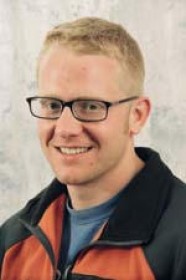
3:00 pm to 12:00 am
Event Location: Newell Simon Hall 3305
Abstract: In a recent demonstration, a monkey was able to feed itself with a robot arm it controlled through a cortical brain-computer interface (BCI) [1]. This work extended past brain control based on 3-D target acquisition alone to add the control of grip aperture. We now extend this further to include the brain control of hand orientation and shape. To do this, we identify two complementary processes that must occur for successful control to take place. First, a model for decoding cortical activity into parameters of robot control must be calibrated accurately for a monkey subject. Second, the monkey must learn this model to become proficient at controlling the device. We introduce a novel system for operator-machine shared control that is integral to systematically promoting both processes.
To demonstrate use of this system, a monkey is being trained to operate a robotic arm and hand (7-axis Barrett WAM Arm, Barrett Hand) using a cortical brain-computer interface. Action potentials from primary motor arm and hand area cortical neurons are recorded with two chronically implanted “Utah” microelectrode arrays (Blackrock Inc). Signals derived from these recordings are used as commands to operate the prosthetic robot in an 8 degree-of-freedom object grasping task. First, we calibrate a model for cortical decoding using observation-based neural spike activity elicited while the animal simply observes the task being performed. A shared control method of integrating decoded cortical activity with an automated guidance system then allows for decoder recalibration while gradually increasing the proportion of control from the brain. Changes in cortical modulation will occur during the transition from robot observation to robot control that will then be captured in the resulting decoding model. After model calibration, the monkey will be trained using another shared control paradigm where control difficulty is matched to the skill of the monkey in brain control of the device. Unskilled robot movements will be regulated with the controller to limit errant movement to an adjustable degree as successful control over the robot emerges. This process will facilitate learning of the decoder by the monkey and complete control of the prosthetic arm and hand.
[1] M Velliste, S Perel, M C Spalding, A S Whitford, and A B Sch
Committee:Andrew Schwartz, Co-chair
Nancy Pollard, Co-chair
George Stetten
Neville Hogan, Massachusetts Institute of Technology
